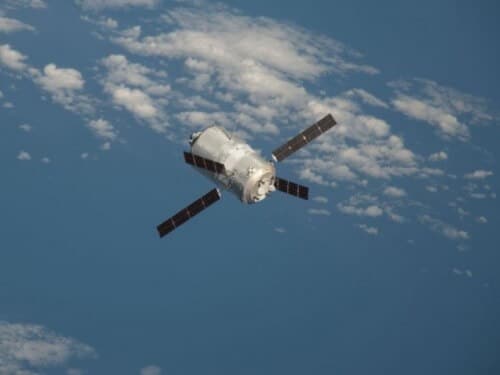After a three-day delay, the European Space Agency's Eduardo Amaldi spacecraft, the third resupply vehicle in the ATV series, left the space station's Zvezda module Friday night

After a three-day delay, the European Space Agency's Eduardo Amaldi spacecraft, the third supply spacecraft in the ATV series, left the space station's Zvezda module Friday night.
A previous attempt, on Thursday, was canceled due to a communication problem between Zvzda's communication component and the spacecraft. The Russian flight controllers solved the problem, but then an additional delay was necessary due to the fear of hitting two pieces of space debris that approached the space station, when the ATV engines are used in such a case as a means of maneuvering the entire station, but later the fear was removed because the fragments traveled a long distance and did not pose a threat.
Team 33 flight engineers Yuri Melanchenko and Aki Hoshida, who together closed the hatches to ATV-3 on Monday, monitored the automatic departure from the Zuzada's control room. Meanwhile, crew chief Sonny Williams photographed the departing spacecraft to document the conditions of the docking complex.
ATV-3 which was full of waste and items no longer needed was driven to a safe distance from the station after docking. When the spacecraft reaches a distance of about 7,000 kilometers from the International Space Station,
The cargo spacecraft's operators, European Space Agency personnel, will fire its engines twice on Tuesday, October 2, sending it into the atmosphere to burn up as planned.
On the way to Earth, a recording device installed inside the vehicle will record the engineering data to enrich the design efficiency of future generations of the spacecraft and minimize the damage to people and property on the ground even in the event of an uncontrolled reentry into the atmosphere of future cargo spacecraft.
Eduardo Amaldi is named after an Italian physicist of the 20th century who is considered one of the people responsible for the European space flight program. The spacecraft has transferred 7.2 tons of food, fuel and supplies to the station since it docked on March 28.
The fourth European cargo spacecraft, which will be named after Albert Einstein, is planned for launch in April 2013. The ATV spacecraft, which are about the size of a typical London double-decker bus, are the largest and heaviest cargo spacecraft in Yore currently serving the supplies and equipment for the station.
For the news in Universe Today

2 תגובות
Because there is no need for it (and the software), and equipment for a soft landing costs a lot of money (which is not currently abundant in Europe)
Question - why do you want this spaceship to burn up in the atmosphere?